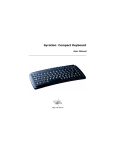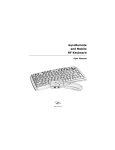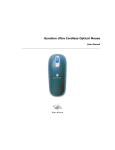Download Gyration TM ULTRA CORDLESS OPTICAL MOUSE Mouse User Manual
Transcript
Gyration Ultra Cordless Optical Mouse ™ User Manual PRODUCT SPECIFICATIONS Spec System Requirements Ultra Cordless Optical Mouse Size Weight Operating Range 4.8"L x 2.0"W x 1.8"H (12.2cm x 5.1cm x 4.5cm) 5.3 oz (150g) with battery pack Ultra - Up to 30 feet (9.144m) typical with no line-of-sight requirement Ultra Professional - Up to 100 feet (30.5m) typical with no line-of-sight requirement Radio 49 MHz (U.S.) with 8 channels and 36,800 security addresses Batteries Connector RF Receiver IBM compatible PCs running Windows 98 (Second Edition), 2000, ME, XP, or higher Available USB port CD ROM drive (for GyroTools installation on Windows only*) Microsoft or Mac compatible mouse driver (no additional drivers to install) NiMH Battery Pack (Note: An additional NiMH battery is included in the Ultra Professional model only.) 3 AAA batteries (Note: An AAA battery clip is included in the Ultra Professional model only.) N/A Operating Temp +10 to 40 C (+50 to +104 F) Storage Temp -30 to +70 C (-86 to +158 F) 3.15"L x 2.85"W x .73"H (8cm x 7.2cm x 1.8cm) 2.16 ounces (67.2g) N/A N/A N/A USB with 5' (1.5m) cable *The E-Mail tool in GyroTools is not supported under Windows 98 (Second Edition). TABLE OF CONTENTS Ultra Mouse .........................................................................1 Key Features ................................................................... 1 Installing and Charging the Batteries .................................. 1 Setting Up and Synchronizing ............................................ 4 Determining the Channel................................................... 5 Changing the Channel....................................................... 5 Powering On and Off........................................................ 6 Using on the Desktop....................................................... 7 Using in the Air ............................................................... 7 Fine-Tuning Cursor Control ............................................... 8 GyroTools Software .......................................................... 9 RF Receiver .......................................................................11 Learn Button ................................................................. 11 Status Light................................................................... 11 Keyboard LEDs .............................................................. 12 Installing 3 or More Devices............................................. 12 Troubleshooting Tips .........................................................14 Regulatory Information .....................................................15 FCC Statement .............................................................. 15 Canadian Radio Interference Regulations ........................... 16 Contacting Gyration...........................................................17 Warranty Information .......................................................18 i Gyration Ultra Cordless Optical Mouse Welcome to a world of unprecedented freedom in surfing, gaming, and mobile computing! Gyration’s Gyro technology delivers the ultimate PC remote control device: the Ultra Mouse. Gyration's patented motion-sensing and radio frequency technologies provide accurate and effortless cursor control from anywhere in the room. Since the Ultra Mouse works on a desktop as well as in the air, sit back and relax. You have the power to control your multimedia and internet commands in the palm of your hand. Key Features Installing and Charging the Batteries Important: The Ultra Mouse must be charged for nine (9) hours prior to its first use. 1 The Ultra Mouse comes with a NiMH battery pack already installed, but you will need to remove the plastic tab located inside the battery compartment. This clear plastic tab prevents the battery from discharging until you are ready to use your mouse. To remove the tab and charge your batteries: 1. Press the Battery Release button at the bottom of the mouse and lift the NiMH battery pack off. 2. Remove and discard the plastic tab. 3. Replace the battery pack by snapping it into place on the mouse. 4. Connect the power adapter to the charging cradle and plug it into a power source. 5. Place the mouse in the charging cradle. The cradle’s LED Indicator light, located at the bottom of the unit, will turn solid green and the LED Indicator light on the mouse will faintly flash green while its batteries are charging. 6. Once the batteries are fully charged, the LED Indicator light on the mouse will maintain a steady glow and will be ready for use. Battery Tips For optimal battery life, avoid using the mouse on darkcolored surfaces. When the battery drops to twenty percent (20%) of its full charge, the LED Indicator light on the mouse will blink intermittently when in use. To optimize the performance of your NiMH battery, it is best to recharge it after every day of use. If a full charge is not required, you can remove the mouse from the charging cradle at anytime. You do not need to wait for the LED Indicator light to stop flashing. To conserve power, the mouse enters a “Sleep Mode” when it is left on for more than 24 hours. To awake from Sleep Mode, click any button. 2 Using the In-Line Battery Charger The In-Line Battery Charger is included with the Ultra Professional model or available for purchase as an add-on accessory. To charge the NiMH battery pack using the in-line battery charger: 1. Connect the power adapter to the in-line battery charger and plug it into a power source. 2. Place the battery pack in the charger and the LED Indicator light will turn solid green. 3. To eliminate the need of one additional adapter, install the smaller connector of the charger cable into the back of the in-line charger and install the larger connector into the front of the charging cradle. Using the Alkaline Battery Clip The Alkaline Battery Clip is included with the Ultra Professional model or available for purchase as an add-on accessory. A standard alkaline battery clip may also be used with your mouse: 1. Insert three AAA batteries into the battery clip. 2. Snap the battery clip into place on the mouse. 3. Install the in-line battery charger cable. If the alkaline battery clip is installed, the mouse enters Sleep Mode when it is left on four or more hours. To awake from Sleep Mode, click any button. Note: The AAA batteries are not recharged when the unit is placed in the charging cradle. 3 Setting Up and Synchronizing the Ultra Mouse and the Gyration RF Receiver When installing the Ultra Mouse for the first time or when adding additional Gyration devices to the system, it is necessary to perform a Teach/Learn sequence to synchronize the devices. To set up and synchronize the Ultra Mouse and the RF Receiver: Note: 1. Ensure the mouse is fully charged. 2. Connect the receiver cable into an available USB port and power on your computer. Your operating system should detect the new hardware device and initiate the installation procedure. Continue to follow the standard USB device installation screens until installation is complete. 3. Press and hold the Learn button on the receiver for two seconds and then release it. The Status light will blink slowly, indicating the receiver is now in “Learn Mode.” 4. Press and release the Teach button located on the bottom of the mouse handset. The Status light on the receiver will blink rapidly for four seconds, then begin to blink slowly. At this time, press the Teach button on any additional devices (such as a keyboard, a second Ultra Mouse, or a GyroRemote). 5. To exit Learn Mode, press the Learn button on the receiver for two seconds. Otherwise, Learn Mode will automatically time out after five minutes. If more than one Gyration device is being installed on the same system, place the receiver into Learn Mode (step 3 above) and then press the Teach button on each device before exiting Learn Mode. However, do not press the Learn button on the receiver for each device to be added (see “Installing 3 or More Devices” on page 12). When the receiver is put into Learn Mode, it erases its memory of previously learned devices and looks for new devices. 4 Therefore when adding a new device to a system, it is necessary to put the receiver into Learn Mode and then press the Teach button on all the devices that will be used on the system. After the Teach/Learn sequence is performed, the receiver and device(s) will remain synchronized after powering down and/or changing channels. It is only necessary to perform the Teach/Learn sequence when setting a device up for the first time or when adding additional devices to the system. Determining Which Channel the Ultra Mouse is Using The Ultra Mouse has eight individual channels available to it. To determine which channel a device is currently using: Note: 1. Press and quickly release the Channel button on the bottom of the mouse handset. 2. Count the number of times the green LED on top of the handset (or the red LED on the bottom of the handset) flashes. The number of flashes indicates the channel the mouse is using. If the mouse’s channel is changed when the computer is powered down or the receiver is not connected, the devices will become unsynchronized. When the system is running, click and release the Channel button as described above to confirm the channel. The mouse broadcasts a message across all eight channels that informs the receiver what channel it is currently operating on. The receiver then automatically restores synchronization. Changing the Channel the Ultra Mouse is Using When two devices are being used in the same proximity, each device should be set to operate on a unique channel. For the best reception, space the channels apart by one or more channels. For example, setting the channels to “2” and “4” is recommended over setting the channels to “2” and “3”. 5 If you are installing three or more devices on a single receiver, see “Installing 3 or More Devices” on page 12. Remember if a Teach/Learn sequence has already been performed, it is not necessary to re-synchronize the devices after a channel change. To change the channel: 1. Press and hold the Channel button on the bottom of the mouse handset for two seconds. 2. When you release the Channel button, the mouse will change to the next sequential channel and the green LED on the top of the handset (and the red LED on the bottom of the handset) will flash. The number of flashes indicates the new channel the mouse is using. Powering the Ultra Mouse On and Off To power on: Simultaneously press and release the Channel and Teach buttons on the bottom of the mouse for three seconds. It will confirm it is powering on by flashing its LED Indicator for one second. To power off: Note: Simultaneously press and release the Channel and Teach buttons on the bottom of the mouse. It will immediately power off and be unresponsive to button clicks. It will confirm it is powering off by flashing its LED Indicator three times. Powering off the mouse prevents battery drain when traveling. It is necessary to power the unit off when traveling on commercial airlines due to FCC regulations regarding radio-emitting devices. 6 Using the Ultra Mouse on the Desktop The Ultra Mouse provides great flexibility in how you control your computer, and its optical sensor allows for precise tracking on virtually any surface. However for optimal performance, avoid highly reflective glass or mirrored surfaces. To use on the desktop: 1. Set up and synchronize the mouse with the receiver (see “Setting Up and Synchronizing the Ultra Mouse and the Gyration RF Receiver” on page 4). 2. Remove the mouse from the charging cradle and place it on a flat surface. The LED light on the receiver base will flicker rapidly when communicating with the mouse handset. 3. Use the mouse like a standard desktop mouse. For optimal battery life, avoid using it on dark-colored surfaces. In addition to its optical sensor, the Ultra Mouse uses an advanced reflective sensor that detects when the mouse is being lifted off the desktop. To conserve battery life, this sensor powers on the gyroscope and shuts down the optical sensor each time the mouse is picked up from the desktop. Using the Ultra Mouse in the Air The Ultra mouse has no lineof-sight requirements so it is not necessary to point the device at the computer, receiver, or monitor. Just find a comfortable, relaxed position and move the cursor with easy wrist movements. 7 1. Set up and synchronize the mouse with the receiver (see “Setting Up and Synchronizing the Ultra Mouse and the Gyration RF Receiver” on page 4). 2. Hold the mouse in a comfortable, relaxed position with your index finger on the Activation Trigger and your thumb at the base of the Scroll Wheel (see illustration). 3. Press and hold the Activation Trigger with your index finger. While holding the trigger, flex your wrist up, down, and sideways (in a manner similar to using a flashlight). The mouse cursor tracks the motions of your hand. Remember, it is not necessary to point the mouse at your computer, receiver, or monitor. 4. Use your thumb to press the left/right mouse buttons or to operate the scroll wheel. Tip: Double-click the Activation Trigger to keep the cursor continuously active. To stop the cursor movement, click the trigger once. Tip: Move the cursor over a target and release the Activation Trigger before clicking the left or right mouse buttons. This “parks” the cursor and allows you to click more accurately. Fine-Tuning Cursor Control Since the Ultra Mouse uses standard Windows or Mac mouse drivers, there are no additional drivers to install. Any settings that are available to a standard desktop mouse (such as cursor tracking speeds and mouse double-click speeds) are also available to the Ultra Mouse. Multiple factors will determine how you adjust your mouse to suit your personal preference including screen resolution and driver version. While becoming familiar with your mouse and getting a feel for the “in air” method of cursor control, Gyration recommends adjusting your mouse driver to the following settings: Pointer Speed – Average. Some new users prefer this setting to be slightly slower than average. Advanced users will increase the speed so that less wrist movement gives them more screen coverage with the cursor. 8 Note: Acceleration – Low or Off. Refer to your operating system’s documentation for additional information on customizing your mouse properties. GyroTools Software GyroTools is a suite of software tools that enhance the functionality of the Ultra Mouse. Assign your favorite tools to buttons on the Ultra Mouse, and put advanced presentation techniques at your fingertips. 1. Note: To install the GyroTools software, insert the GyroTools disk into your CD drive and follow the on-screen instructions. If the program does not start after a few moments, go to My Computer (located on your desktop), click to your CD drive, and open SETUP.EXE. Once GyroTools has been installed, complete operating instructions are available by accessing the on-line help. 2. Once the installation is complete, click on the GyroTools icon in the Start menu to launch the GyroTools application. 3. Tools can be assigned to a double right-click, a right-click and hold, or a right-click followed by left-click. Tools can also be assigned to the scroll wheel (i.e., double scrollclick, scroll-click and hold, scroll-click followed by leftclick). There are other methods to activate tools such as screen hotspots, swipes, and scheduled events. 4. To assign tools using the Drag and Drop Toolbox: a. Select the tool group (such as General, Internet, or Media located at the bottom of the GyroTools window) that contains the tool(s) you want to assign. b. Left-click and hold the desired tool. 9 c. 5. Drag the tool onto the icon square next to the button that you wish to assign the tool to and release the button. To assign tools using the Menu-Driven Method: a. Right-click the icon square next to the thumb button that you wish to assign. b. Select the New Tool or Replace Tool menu command. c. Select the tool group (such as General, Internet, or Media located at the bottom of the GyroTools window) that contains the tool(s) you want to assign. d. Select the desired tool from the menu. e. Once the tool is selected, you can define the tool’s properties (such as color, border, and other parameters). 6. Once a tool has been assigned to a button, simply press the button sequence to invoke the tool. 7. When finished using the tool, right-click and the pointer returns to cursor mode. 10 Gyration RF Receiver Learn Button Pressing the Learn button for two seconds puts the receiver into Learn Mode allowing you to synchronize one or more devices with the receiver. After the devices have been synchronized, pressing the Learn button again for two seconds takes the receiver out of Learn Mode. If the receiver is not manually taken out of Learn Mode, it will automatically return to Normal Mode after five minutes. Status Light The Status light displays useful information about the modes of operation and the connection between the receiver and transmitter(s). Its various states are: Remains off when the receiver is operating in Normal 11 Mode and no devices are transmitting. Blinks slowly (one blink per second) when the receiver is in Learn Mode and is awaiting a Teach instruction from a device. Flickers rapidly when the receiver is operating in Normal Mode and a synchronized device is transmitting. If there is radio interference, the flickering light will be inconsistent. Blinks rapidly for a four-second burst when it is in Learn Mode processing a Teach instruction, and synchronizing the receiver with the device. Keyboard LEDs These LEDs indicate whether your computer has the Num Lock, Caps Lock, and/or Scroll Lock features activated. Num Lock: Used to toggle a combination number/cursor keypad between numeric keys and cursor keys. Caps Lock: When activated, causes all alphabetic characters to be uppercase but has no effect on other keys. Scroll Lock: Used to toggle between scrolling and nonscrolling mode (on PC keyboards). When activated, the arrow keys scroll the screen regardless of the current cursor location. Installing 3 or More Devices The RF receiver can be taught to recognize up to eight devices (such as mice, remotes, and keyboards) on a system, but only two of those devices may be used simultaneously. When setting up a system with a single receiver and three or more devices, the following guidelines must be followed: Select two channels that are free of outside interference and install all devices on either of those two channels. When possible, it is recommended that the two chosen 12 channels be separated by at least one unused channel. For example, setting the channels to “2” and “4” is recommended over setting the channels to “2” and “3”. Any of the devices installed on one channel may be used simultaneously with any of the devices on the other channel. Two devices that share a channel may be used alternately. When installing the devices try to determine which devices will be used simultaneously and set them on opposite channels. Example: Mouse One is used by a presenter for cursor control, and Mouse Two and a keyboard are used by an assistant to input data. Mouse One is set at channel 3. Mouse Two is also set at channel 3 and the keyboard is set at channel 5. With this configuration, Mouse One and the keyboard can be used simultaneously. Or, Mouse Two and the keyboard can be used simultaneously. However since Mouse One and Mouse Two share the same channel, they can only be used alternately. A low-power consumer device (i.e., Ultra Mouse with 30ft. range) should not be used simultaneously with a highpower professional device (i.e., RF Keyboard with 100-ft. range). One or both devices may not work properly if data is being transmitted by the two units at the same time. For optimal simultaneous performance, it is recommended that you use two low-powered devices or two high-powered devices. If you wish to use both a high- and low-power device simultaneously, it is recommended that you alternate usage between the devices. 13 Ultra Mouse Troubleshooting Tips Symptom Reason Solution Mouse LED comes on when activate button is pressed, but receiver is unresponsive Mouse and Receiver not synchronized Perform a Teach/Learn sequence (see “Setting Up and Synchronizing the Ultra Mouse and the Gyration RF Receiver” on page 4). When using in air, cursor is visible but shows no movement Gyro not activated Squeeze or double-click trigger on bottom of mouse. Cursor movement is choppy or erratic Radio interference Change the device’s channel setting (see “Changing the Channel the Ultra Mouse is Using” on page 5). Move receiver away from other electronic devices (e.g. monitor, speakers, radio, etc.). Raise receiver antenna and/or uncoil USB Receiver cable. When pressing the activate button, the LED on the mouse is flashing Batteries are low When pressing the activation trigger, the LED on the mouse is off Batteries are dead Mouse is off Power it on (see “Powering the Ultra Mouse On and Off” on page 6). Cursor moves too fast or too slow Speed or acceleration not set properly Change the cursor tracking speed in the mouse control panel. Cursor drifts on the screen Sensor may require recalibration Place the mouse on the desk for 4 or more seconds to steady the cursor. Mouse LED does not flash in charging cradle and mouse does not charge Dirty contacts Clean the contacts on bottom of mouse. Improper battery installed Make sure that the AAA battery pack is not installed. Inadequate battery life Recharge battery pack or replace (see “Installing and Charging the Batteries” on page 1). End-of-life battery Replace battery. Mouse used on darkcolored surface Use mouse on light-colored surface to minimize battery drain. 14 Regulatory Information Attention! This device emits radio frequencies and has not been certified by the FAA for use onboard aircraft. Do not use this device at any time onboard civil aircraft. To minimize the possibility of interference, power off the Ultra Mouse to ensure the device remains off during flight. FCC Statement The Ultra Cordless Optical Mouse and RF Receiver have been tested and found to comply with the limits for a Class B digital device, pursuant to Part 15 of the FCC Rules. These limits are designed to provide reasonable protection against harmful interference in a residential installation. This equipment generates, uses and radiates radio frequency energy and, if not installed and used in accordance with the instructions, may cause harmful interference to radio communications. However, there is no guarantee that interference will not occur in a particular installation. If this equipment does cause harmful interference to radio or television reception, which can be determined by turning the equipment off and on, the user is encouraged to try to correct the interference by one or more of the following measures: 1. Reorient or relocate the receiving antenna (television, radio, etc.). 2. Increase the separation between the equipment and receiver. 3. Connect the equipment to an outlet on a circuit different from that to which the receiver is connected. 4. Consult the dealer or an experienced radio/TV technician for additional help. Caution: Changes or modifications not expressly approved by the party responsible for compliance could void the user's authority to operate the equipment. Contact Gyration, Inc., 12930 Saratoga Avenue, Bldg. C, Saratoga CA 95070. Technical Support: 408-973-7086. These devices comply with Part 15 of the FCC Rules. 15 The Compact Keyboard operates in the frequency band of 49.825 to 49.895 MHz with RF output power of less than 30 MicroWatts EIRP (Effective Isotropic Radiated Power). Warning: Using these products in any way other than as described in this manual or altering the antenna in any way may violate FCC rules. FCC ID: JJ4-GP221-001 Compact Keyboard; Receiver: AS00262-001 DECLARATION OF CONFORMITY We GYRATION, INC. 12930 Saratoga Avenue, Suite C Saratoga, CA 95070 Phone 408-255-3016 Declare under our sole responsibility that the product USB MINI DUAL RECEIVER PART NO. AS00262-001 Complies with Part 15 of the FCC Rules Operation is subject to the following two conditions: 1. these devices may not cause harmful interference, and 2. these devices must accept any interference received, including interference that may cause undesired operation. Canadian Radio Interference Regulations This Class B digital apparatus meets all requirements of the Canadian Interference Causing Equipment Regulations. Cet appareil numérique de la classe B respecte toutes les exigences du Règelement sur le matériel brouil-leur du Canada. 16 Contacting Gyration If you have any questions on your new Gyration product, please contact us. Main Office Gyration, Inc. Phone: 408-255-3016 Fax: 408-255-9075 Sales Phone: 800-316-5432 (Toll-free in US and Canada) Fax: 408-387-5130 E-mail: [email protected] Technical Support Phone: 408-973-7086 Fax: 408-973-7669 E-mail: [email protected] Product Support: www.gyration.com/support.htm World Wide Web www.gyration.com Technical Support-UK Phone: 0870 442 8669 E-mail: [email protected] Technical Support-Germany Phone:0 61 81 / 94 36 33 70 E-mail: [email protected] 17 17 17 Warranty Information Gyration products come with a two-year hardware warranty. Gyration, Inc., (Gyration) warrants products against defects in material and workmanship for a period of two years from the date of purchase from Gyration or an authorized Gyration agent. This warranty applies only to the original purchaser and is not transferable. This warranty does not cover any incompatibilities due to the user's computer, hardware, software or any other related system configuration in which the product interfaces. Proof of purchase will be required before any warranty consideration by Gyration occurs. This warranty does not cover any damage caused by negligence, non-authorized modifications, or parts installed without prior written permission from Gyration. This warranty does not apply if the product has been damaged by accident, abuse, misuse, or misapplication, nor as a result of service to the product by anyone other than by Gyration. Gyration is not responsible for any lost profits, lost savings or other incidental or consequential damages arising out of the use of, or inability to use, this product. This includes damage to property and, to the extent permitted by law, damages for personal injury. This warranty is in lieu of all other warranties including implied warranties of merchantability and fitness for a particular purpose. Some states do not allow limitation of implied warranties, or exclusion or limitation of incidental or consequential damages, so the above limitations may not apply to you. This warranty gives you specific legal rights. You may have other rights which may vary from state to state. This warranty applies only to these products, and is governed by the laws of the State of California. Trademark Information © 2003 Gyration, Inc. All rights reserved. Gyration and the Gyration logo are trademarks of Gyration, Inc. in the United States and other countries. All other trade names mentioned are the property of their respective companies. US Patent Numbers: 5,440,326; 5,898,421; 5,825,350 and other pending patents. 18 Gyration Ultra Cordless Optical Mouse User Manual DL00049-001 Rev B Gyration, Inc. 408.255.3016 www.gyration.com

































